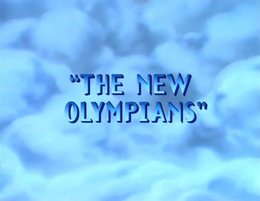The New Olympians
Story Editor: Gary Sperling
Writer: Adam Gilad
Director: Bob Kline
Summary
Tidbits
The New Olympians were projected to have their own spin-off, like King Arthur and Griff in Pendragon. In it, a young man named Terry Chung would be shipwrecked on New Olympus while sailing around the world by himself, and his arrival would serve as the catalyst for the New Olympians deciding to announce themselves to the world, in the form of Taurus, Talos, and a young female New Olympian named Sphinx (based roughly on the Sphinx of Greek mythology, though with a more humanoid build) travelling to the United Nations Building in Terry's company to present their credentials to an astonished humanity. The series would have focused from there on the impact of the New Olympians' revealing themselves, including further schemes from Proteus, Xanatos entering into trading relations with New Olympus for his own benefit, an attempt by a New Olympian named Jove and his followers to make the humans worship the New Olympians as gods once more (just as they had done in ancient times), and a Romeo and Juliet-type relationship between Terry and Sphinx. (The concept of the spin-off was originally developed by Bob Kline even before Gargoyles was proposed, and imported into Gargoyles with a few minor tweaks to make it fit it in better with the series' universe.)
The individual New Olympians in this episode are all based on figures in Greek mythology, and even named after them. To provide a brief summary:
Boreas Boreas was named after the god of the north wind. His depiction as a winged human was inspired by the fact that, in Greek myth, Boreas had two half-human sons named Calais and Zetes who bore wings (they were among the crew of the Argo during the Quest of the Golden Fleece, and distinguished themselves in battling the harpies that were plaguing old King Phineus); Calais and Zetes, incidentally, would have had namesake counterparts in the projected spin-off.
Ekidne Ekidne's name was derived from Echidna, who looked like a beautiful woman from the waist up, a serpent from the waist down, and was the mate of the monstrous Typhon, bearing him many equally monstrous children, including the Nemean Lion, the Lernean Hydra, Cerberus, the Chimera, and the Sphinx. Since Ekidne was to have a daughter named Medusa in the spin-off, it appears that the production team had decided to associate her as much with the Gorgons as with Echidna.
Helios The original Helios was the god of the sun in Greek myth (Apollo assumed this function only very late in classical times).
Kiron Kiron was named after Chiron, a wise old centaur who lived on Mount Pelion and served as a teacher for many of the great heroes of Greek mythology during their youth, such as Jason and Achilles. (Judging from his serious prejudice towards humans and his willingness to take part in the riot, Kiron clearly lacks the wisdom of his namesake ancestor.)
Proteus The original Proteus was a shape-shifting sea-god, though more benevolent than his namesake on New Olympus. In Book Four of Homer's Odyssey, King Menelaus of Sparta recounts the story of how he encountered Proteus when he was becalmed on his way home from the Trojan War off the coast of Egypt, and had to defeat him in a wrestling match (Proteus assuming every form that he could think of to make it difficult for Menelaus) in order to find out how to finally get back home to Greece. The treacherous nature of the Proteus of Gargoyles might have been influenced by the tendency in literature since then to associate the mythical Proteus with similar traits (cf. the Proteus of Shakespeare's The Two Gentlemen of Verona, a thoroughly two-faced fellow who sells out his best friend Valentine without a qualm of conscience and abandons his girl-friend Julia to woo Valentine's love, Silvia).
Talos Talos is the only New Olympian to be an actual survivor from Greek mythology, rather than a mere namesake descendant. In the Greek myths, Talos was a robot made of living bronze, built by the master-inventor Daedalus and presented to King Minos of Crete to defend his island kingdom from invaders; Talos would patrol the Cretan shore and throw rocks at any enemy ships approaching to sink them (afterwards heating himself up to burn to death any survivors that made it to shore). He was finally destroyed by the sorceress Medea, who took advantage of his one weak spot, a plug in the back of his ankle which, when removed, caused his vital fluids to spill out (evocative of Achilles' heel). Apparently, in the Gargoyles Universe, Talos was rebuilt after this fatal encounter with Medea (not for the last time, obviously; the fact that he would appear in the spin-off indicates that he would have to be repaired after being smashed by Proteus) and decided to join the New Olympians in their withdrawal from the outside world. So far, there is no indication as to whether Talos can still heat himself up. (Talos has also made an appearance in Edmund Spenser's The Faerie Queene, where he served as squire to Sir Artegal, the Knight of Justice.)
Taurus A descendant of the Minotaur, and a bull-headed man like his famous ancestor, Taurus was named after the Greek word for "bull" (borne also by one of the constellations in the Zodiac, representing Zeus in bull-form carrying Europa away to Crete).
The New Olympians recognize Goliath, Angela, and Bronx as gargoyles at once and are well-disposed towards them. According to Greg Weisman, there is an actual gargoyle clan on New Olympus (but one which apparently didn't bother showing up to greet the visitors).
Links
| << Previous Episode: "Eye of the Storm" | Next Episode: "The Green" >> |
